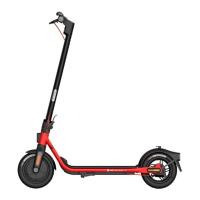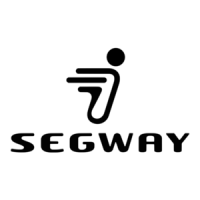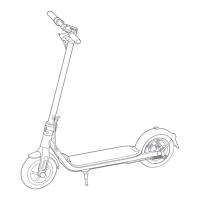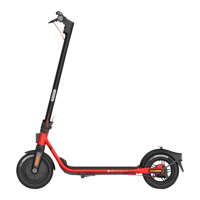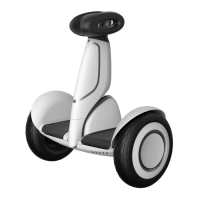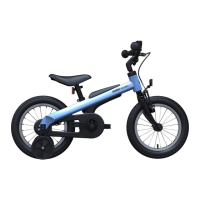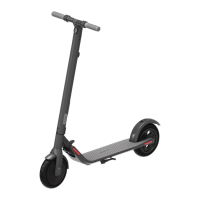11 Specifications
[1] Typical Riding Time: tested while riding under full power, 165 lbs (75 kg) load, 77°F (25°C), 5 mph (8 km/h) average speed on
flat hard ground.
[2] Max. Slope: tested while riding with the payload of 165 lbs (75 kg) and speed less than 3 mph (5km/h).
Product Name Segway Drift W1
Dimensions
Weight
Rider
Machine
Parameters
Battery
Motors
Charger
11.5×6.4×4.8 in (291×162×121 mm)
12.5×10.6×8.7 in (318×269×219 mm)
22–220 lbs (10–100 kg)
Approx. 7.7 lbs (3.5 kg)
45 minutes
10°
22.2 VDC
14–104°F (-10–40°C)
-4–122°F (-20–50°C)
25.2 VDC
32–104°F (0–40°C)
44.4 Wh
100-240 VAC
25 ± 0.2 VDC
1.5A
37.5 W
Mainframe (single wheel)
Unit
Payload
Net (single wheel)
6+ years old. See the weight limit
Recommended Age
Max. Speed
Typical Riding Time
[1]
Max. Slope
[2]
Operating Temperature
Storage Temperature
Mainframe IP54/ Battery pack IPX6IP Rating
Max. Storage Time
Approx. 180 days/100% power;
Approx. 30 days/30% power
Charge Time (for both mainframes) Approx. 3 hours
Traversable Terrain
Max. Charging Voltage
Charging Temperature
Nominal Capacity
Over-voltage, under-voltage, over-current, short circuit, and
over-heating protection. Auto-sleep, auto-balance, and auto-wake.
Battery Management System
Input Voltage
Output Voltage
Output Current
Nominal Voltage
6 NmMax. torque (single wheel)
Output Power
Flat, hard ground free of bumps or obstacles
Approx. 7.5 mph (12 km/h)
Top speed will vary based on riding style and remaining battery life.
Top speed will be reduced when the battery is low.
12 Certifications
This product has been tested and passed ANSI/CAN/UL-2272.
The battery complies with UN/DOT 38.3
Federal Communications Commission (FCC) Compliance Statement for USA
This device complies with part 15 of the FCC rules. Operation is subject to the following two conditions: (1) This device
may not cause harmful interference, and (2) this device must accept any interference received, including interference
that may cause undesired operation.
NOTE
This equipment has been tested and found to comply with the limits for a Class B digital device, pursuant to part 15 of
the FCC Rules. These limits are designed to provide reasonable protection against harmful interference in a residential
installation. This equipment generates, uses and can radiate radio frequency energy and, if not installed and used in
accordance with the instructions, may cause harmful interference to radio communications. However, there is no
guarantee that interference will not occur in a particular installation. If this equipment does cause harmful interference
to radio or television reception, which can be determined by turning the equipment off and on, the user is encouraged to
try to correct the interference by one or more of the following measures:
—Reorient or relocate the receiving antenna.
—Increase the separation between the equipment and receiver.
—Connect the equipment into an outlet on a circuit different from that to which the receiver is connected.
—Consult the dealer or an experienced radio/TV technician for help.
Industry Canada (IC) Compliance Statement for Canada
This device complies with Industry Canada license-exempt RSS standard (s). Operation is subject to the following two
conditions: (1) this device may not cause interference, and (2) this device must accept any interference, including
interference that may cause undesired operation of the device.
CAN ICES-3 (B)/NMB-3(B)
Neither Segway Inc. nor Ninebot is responsible for any changes or modifications not expressly approved by Segway Inc.
or Ninebot. Such modifications could void the user's authority to operate the equipment.
14 15

